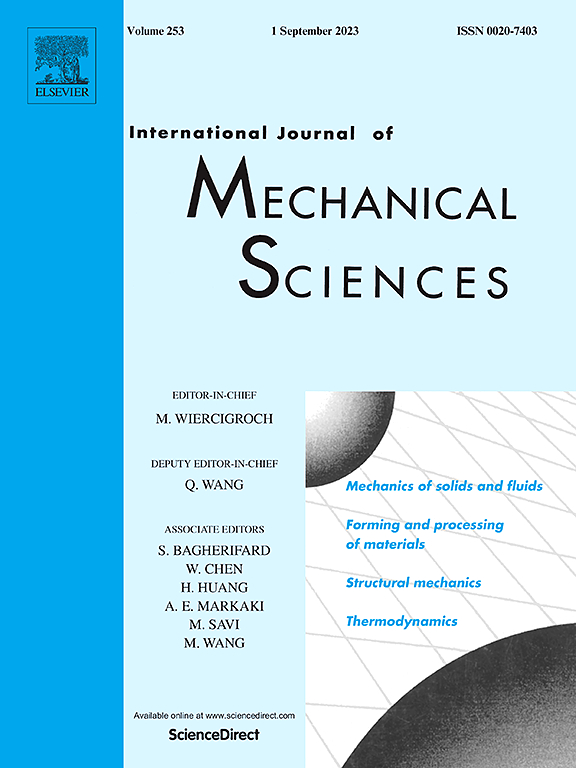蠕变主导的拉伸应力-应变数据分析
IF 7.1
1区 工程技术
Q1 ENGINEERING, MECHANICAL
International Journal of Mechanical Sciences
Pub Date : 2025-04-20
DOI:10.1016/j.ijmecsci.2025.110295
引用次数: 0
摘要
提出了一种新的分析拉伸名义应力-应变数据,涵盖应变率范围,在这种情况下,行为是由蠕变占主导地位。例题计算使用了一些出版物的报告结果:没有提出新的实验数据。分析的一个重要部分是将原始标称数据转换为应力、应变和应变率的真实值。描述了从这种类型的实验数据中提取蠕变特性的两种方法。第一种是基于简单的对数图,结合了真实应力和相应的真实蠕变应变率,从具有给定标称应变率的每次测试中获得。另一种方法是使用简单的数值模型,可以使用电子表格实现,通过优化实验和模拟应力-应变曲线之间的拟合获得蠕变参数值。这些方法为通过实验程序获得蠕变参数提供了吸引力,这些实验程序比传统的蠕变测试更简单,更可靠,更容易执行。然而,它们仅适用于蠕变速率相对较高且没有早期颈缩的情况。本文章由计算机程序翻译,如有差异,请以英文原文为准。

Analysis of creep-dominated tensile stress-strain data
A novel analysis is presented of tensile nominal stress-strain data, covering a range of strain rates, for cases in which the behaviour is dominated by creep. Example calculations are carried out using reported outcomes from several publications: no new experimental data are presented. An important part of the analysis is conversion of the raw nominal data to true values, for stress, strain and strain rate. Two procedures are described for extraction of creep characteristics from experimental data of this type. The first is based on a simple logarithmic plot, with a combination of a true stress and a corresponding true creep strain rate being obtained from each test having a given nominal strain rate. The other involves the use of a simple numerical model, which can be implemented using a spreadsheet, with creep parameter values being obtained via optimisation of the fit between experimental and modelled stress-strain curves. These approaches offer attractions for obtaining creep parameters via experimental procedures that are simpler, more robust and easier to carry out than those of conventional creep testing. They are, however, applicable only to cases for which the rates of creep are relatively high and there is no early necking.
求助全文
通过发布文献求助,成功后即可免费获取论文全文。
去求助
来源期刊

International Journal of Mechanical Sciences
工程技术-工程:机械
CiteScore
12.80
自引率
17.80%
发文量
769
审稿时长
19 days
期刊介绍:
The International Journal of Mechanical Sciences (IJMS) serves as a global platform for the publication and dissemination of original research that contributes to a deeper scientific understanding of the fundamental disciplines within mechanical, civil, and material engineering.
The primary focus of IJMS is to showcase innovative and ground-breaking work that utilizes analytical and computational modeling techniques, such as Finite Element Method (FEM), Boundary Element Method (BEM), and mesh-free methods, among others. These modeling methods are applied to diverse fields including rigid-body mechanics (e.g., dynamics, vibration, stability), structural mechanics, metal forming, advanced materials (e.g., metals, composites, cellular, smart) behavior and applications, impact mechanics, strain localization, and other nonlinear effects (e.g., large deflections, plasticity, fracture).
Additionally, IJMS covers the realms of fluid mechanics (both external and internal flows), tribology, thermodynamics, and materials processing. These subjects collectively form the core of the journal's content.
In summary, IJMS provides a prestigious platform for researchers to present their original contributions, shedding light on analytical and computational modeling methods in various areas of mechanical engineering, as well as exploring the behavior and application of advanced materials, fluid mechanics, thermodynamics, and materials processing.
 求助内容:
求助内容: 应助结果提醒方式:
应助结果提醒方式:


